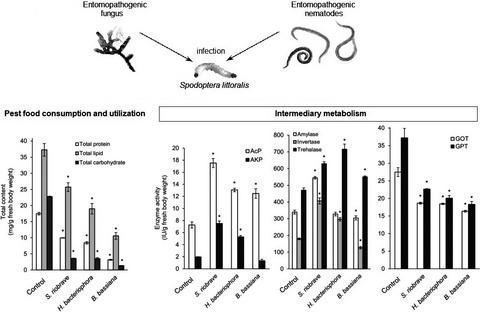当前位置:
X-MOL 学术
›
Entomol. Exp. Appl.
›
论文详情
Our official English website, www.x-mol.net, welcomes your feedback! (Note: you will need to create a separate account there.)
Pathogen‐mediated modulation of host metabolism and trophic interactions in Spodoptera littoralis larvae
Entomologia Experimentalis et Applicata ( IF 1.9 ) Pub Date : 2020-11-23 , DOI: 10.1111/eea.12998 El‐Sayed H. Shaurub 1 , Naglaa F. Reyad 2 , Amr A. Mohamed 1
Entomologia Experimentalis et Applicata ( IF 1.9 ) Pub Date : 2020-11-23 , DOI: 10.1111/eea.12998 El‐Sayed H. Shaurub 1 , Naglaa F. Reyad 2 , Amr A. Mohamed 1
Affiliation

|
The success and sustainability of entomopathogens in insect control depend on their stress potential and ability to modulate certain physiological aspects of their insect hosts. In the present study, newly moulted fourth instars of Spodoptera littoralis (Boisduval) (Lepidoptera: Noctuidae) were incubated for 24 h with the median lethal dose (LD50) of Steinernema riobrave, Heterorhabditis bacteriophora, or Beauveria bassiana to determine their effects on certain metabolic activities and nutritional physiology compared to those of uninfected (control) larvae. Infection decreased total protein, lipid, and carbohydrate contents. Carbohydrase activity was found to be pathogen and enzyme dependent, with S. riobrave and H. bacteriophora infection increasing amylase, invertase, and trehalase activities. Beauveria bassiana infection decreased amylase and invertase activities but increased that of trehalase. Infection with the three pathogens also enhanced phosphatase activity. All pathogens reduced transaminase activity. Changes in the nutritional indices varied not only with the variation in the candidate entomopathogen and surviving instar but also with the variation in the age of the same instar, with a profound change in late last instars (3‐day‐old sixth instars). The link between the metabolic activities and nutritional indices was discussed. Overall, the entomopathogen‐host interaction appears to be primarily nutritional. The pleiotropic effects of the median lethal infections on the insect pest might eventually help in the biological control potential of the entomopathogens tested.
中文翻译:

病原体介导的斜纹夜蛾幼虫宿主代谢和营养相互作用的调节
昆虫病原体在昆虫控制中的成功和可持续性取决于它们的压力潜力和调节昆虫宿主某些生理方面的能力。在本研究中,新蜕皮的滨海斜纹夜蛾(Boisduval)(鳞翅目:夜蛾科)与 Steinernema riobrave、Heterorhabditis bacteriophora 或 Beauveria bassiana 的中位致死剂量 (LD50) 孵育 24 小时,以确定它们对某些代谢的影响与未感染(对照)幼虫的活动和营养生理学相比。感染降低了总蛋白质、脂质和碳水化合物的含量。发现糖酶活性依赖于病原体和酶,S. riobrave 和 H. bacteriophora 感染增加了淀粉酶、转化酶和海藻糖酶的活性。白僵菌感染降低了淀粉酶和转化酶的活性,但增加了海藻糖酶的活性。感染这三种病原体也增强了磷酸酶活性。所有病原体都降低了转氨酶活性。营养指标的变化不仅随着候选昆虫病原和存活龄期的变化而变化,而且随着同龄期年龄的变化而变化,晚龄期(3天龄的六龄期)变化较大。讨论了代谢活动和营养指数之间的联系。总体而言,昆虫病原体-宿主相互作用似乎主要是营养方面的。中位数致死感染对害虫的多效作用可能最终有助于测试昆虫病原体的生物控制潜力。感染这三种病原体也增强了磷酸酶活性。所有病原体都降低了转氨酶活性。营养指标的变化不仅随着候选昆虫病原和存活龄期的变化而变化,而且随着同龄期年龄的变化而变化,晚龄期(3天龄的六龄期)变化较大。讨论了代谢活动和营养指数之间的联系。总体而言,昆虫病原体-宿主相互作用似乎主要是营养方面的。中位数致死感染对害虫的多效作用可能最终有助于测试昆虫病原体的生物控制潜力。感染这三种病原体也增强了磷酸酶活性。所有病原体都降低了转氨酶活性。营养指标的变化不仅随着候选昆虫病原和存活龄期的变化而变化,而且随着同龄期年龄的变化而变化,晚龄期(3天龄的六龄期)变化较大。讨论了代谢活动和营养指数之间的联系。总体而言,昆虫病原体-宿主相互作用似乎主要是营养方面的。中位数致死感染对害虫的多效作用可能最终有助于测试昆虫病原体的生物控制潜力。营养指标的变化不仅随着候选昆虫病原和存活龄期的变化而变化,而且随着同龄期年龄的变化而变化,晚龄期(3天龄的六龄期)变化较大。讨论了代谢活动和营养指数之间的联系。总体而言,昆虫病原体-宿主相互作用似乎主要是营养方面的。中位数致死感染对害虫的多效作用可能最终有助于测试昆虫病原体的生物控制潜力。营养指标的变化不仅随着候选昆虫病原和存活龄期的变化而变化,而且随着同龄期年龄的变化而变化,晚龄期(3天龄的六龄期)变化较大。讨论了代谢活动和营养指数之间的联系。总体而言,昆虫病原体-宿主相互作用似乎主要是营养方面的。中位数致死感染对害虫的多效作用可能最终有助于测试昆虫病原体的生物控制潜力。总体而言,昆虫病原体-宿主相互作用似乎主要是营养方面的。中位数致死感染对害虫的多效作用可能最终有助于测试昆虫病原体的生物控制潜力。总体而言,昆虫病原体-宿主相互作用似乎主要是营养方面的。中位数致死感染对害虫的多效作用可能最终有助于测试昆虫病原体的生物控制潜力。
更新日期:2020-11-23
中文翻译:

病原体介导的斜纹夜蛾幼虫宿主代谢和营养相互作用的调节
昆虫病原体在昆虫控制中的成功和可持续性取决于它们的压力潜力和调节昆虫宿主某些生理方面的能力。在本研究中,新蜕皮的滨海斜纹夜蛾(Boisduval)(鳞翅目:夜蛾科)与 Steinernema riobrave、Heterorhabditis bacteriophora 或 Beauveria bassiana 的中位致死剂量 (LD50) 孵育 24 小时,以确定它们对某些代谢的影响与未感染(对照)幼虫的活动和营养生理学相比。感染降低了总蛋白质、脂质和碳水化合物的含量。发现糖酶活性依赖于病原体和酶,S. riobrave 和 H. bacteriophora 感染增加了淀粉酶、转化酶和海藻糖酶的活性。白僵菌感染降低了淀粉酶和转化酶的活性,但增加了海藻糖酶的活性。感染这三种病原体也增强了磷酸酶活性。所有病原体都降低了转氨酶活性。营养指标的变化不仅随着候选昆虫病原和存活龄期的变化而变化,而且随着同龄期年龄的变化而变化,晚龄期(3天龄的六龄期)变化较大。讨论了代谢活动和营养指数之间的联系。总体而言,昆虫病原体-宿主相互作用似乎主要是营养方面的。中位数致死感染对害虫的多效作用可能最终有助于测试昆虫病原体的生物控制潜力。感染这三种病原体也增强了磷酸酶活性。所有病原体都降低了转氨酶活性。营养指标的变化不仅随着候选昆虫病原和存活龄期的变化而变化,而且随着同龄期年龄的变化而变化,晚龄期(3天龄的六龄期)变化较大。讨论了代谢活动和营养指数之间的联系。总体而言,昆虫病原体-宿主相互作用似乎主要是营养方面的。中位数致死感染对害虫的多效作用可能最终有助于测试昆虫病原体的生物控制潜力。感染这三种病原体也增强了磷酸酶活性。所有病原体都降低了转氨酶活性。营养指标的变化不仅随着候选昆虫病原和存活龄期的变化而变化,而且随着同龄期年龄的变化而变化,晚龄期(3天龄的六龄期)变化较大。讨论了代谢活动和营养指数之间的联系。总体而言,昆虫病原体-宿主相互作用似乎主要是营养方面的。中位数致死感染对害虫的多效作用可能最终有助于测试昆虫病原体的生物控制潜力。营养指标的变化不仅随着候选昆虫病原和存活龄期的变化而变化,而且随着同龄期年龄的变化而变化,晚龄期(3天龄的六龄期)变化较大。讨论了代谢活动和营养指数之间的联系。总体而言,昆虫病原体-宿主相互作用似乎主要是营养方面的。中位数致死感染对害虫的多效作用可能最终有助于测试昆虫病原体的生物控制潜力。营养指标的变化不仅随着候选昆虫病原和存活龄期的变化而变化,而且随着同龄期年龄的变化而变化,晚龄期(3天龄的六龄期)变化较大。讨论了代谢活动和营养指数之间的联系。总体而言,昆虫病原体-宿主相互作用似乎主要是营养方面的。中位数致死感染对害虫的多效作用可能最终有助于测试昆虫病原体的生物控制潜力。总体而言,昆虫病原体-宿主相互作用似乎主要是营养方面的。中位数致死感染对害虫的多效作用可能最终有助于测试昆虫病原体的生物控制潜力。总体而言,昆虫病原体-宿主相互作用似乎主要是营养方面的。中位数致死感染对害虫的多效作用可能最终有助于测试昆虫病原体的生物控制潜力。



























 京公网安备 11010802027423号
京公网安备 11010802027423号